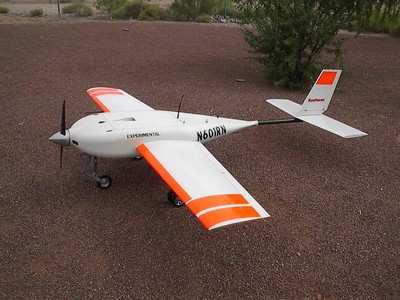Sat, Nov 04, 2006
Tiny Aircraft To Help Company Develop Unmanned Systems
 Raytheon received an Experimental
Airworthiness Certificate (EAC) for its Cobra Unmanned Aircraft
System (UAS). This is the third unmanned aircraft and the first of
its size certified by the FAA.
Raytheon received an Experimental
Airworthiness Certificate (EAC) for its Cobra Unmanned Aircraft
System (UAS). This is the third unmanned aircraft and the first of
its size certified by the FAA.
Raytheon says the Cobra is a low-cost, highly reliable UAS
designed to support the development, integration and test of its
unmanned systems technologies. The aircraft has a wingspan of 10
feet and is 9-feet long -- no wonder it's unmanned!

Restrictions to the Cobra's EAC permit flight operations only in
a specified section of Southeastern Arizona. The EAC authorizes
Raytheon to conduct research and development, crew training and
market surveys using the Cobra UAS.
In furthering the development of Raytheon's unmanned systems, it
will use the Cobra test bed to test and demonstrate sensor systems;
networked command, control and communications systems; and UAS
architectural concepts.
Raytheon's vice president of Missile Systems Ken Pederson said,
"The Cobra UAS will significantly decrease costs and compress
schedules for bringing new UAS technologies to market. Our
customers will benefit from our ability to support both internal
Raytheon development efforts and their programs with Cobra, without
increasing the pressure on tactical systems and valuable range
resources."
Raytheon worked closely with the FAA to receive the Experimental
Aircraft Certification, providing Cobra UAS design, manufacturing,
maintenance, safety, operations and training documentation for its
review and approval. The final step in the certification process
was a demonstration of Cobra UAS ground operations conducted under
the observation of FAA teams from Washington and Phoenix.
The Cobra UAS is composed of the aircraft and ground elements.
The ground element consists of two control systems -- the Cloud Cap
Technology Piccolo Ground Control Station and the Raytheon IIS
next-generation Multi-Vehicle Control System (MVCS). The MVCS uses
the NATO Standardization Agreement (STANAG) 4586 interface to
communicate with the Cobra aircraft. The dual control system
configuration provides for maximum flexibility and safety during
testing.
More News
From 2023 (YouTube Version): Legacy of a Titan Robert (Bob) Anderson Hoover was a fighter pilot, test pilot, flight instructor, and air show superstar. More so, Bob Hoover was an i>[...]
Get The Latest in Aviation News NOW on Instagram Are you on Instagram yet? It's been around for a few years, quietly picking up traction mostly thanks to everybody's new obsession >[...]
Aero Linx: B-52H Stratofortress The B-52H Stratofortress is a long-range, heavy bomber that can perform a variety of missions. The bomber is capable of flying at high subsonic spee>[...]
Altimeter Setting The barometric pressure reading used to adjust a pressure altimeter for variations in existing atmospheric pressure or to the standard altimeter setting (29.92).>[...]
"Knowing that we play an active part in bettering people's lives is extremely rewarding. My team and I are very thankful for the opportunity to be here and to help in any way we ca>[...]
 Classic Aero-TV: Remembering Bob Hoover
Classic Aero-TV: Remembering Bob Hoover ANN FAQ: Follow Us On Instagram!
ANN FAQ: Follow Us On Instagram! ANN's Daily Aero-Linx (05.15.24)
ANN's Daily Aero-Linx (05.15.24) ANN's Daily Aero-Term (05.15.24):Altimeter Setting
ANN's Daily Aero-Term (05.15.24):Altimeter Setting Aero-News: Quote of the Day (05.16.24)
Aero-News: Quote of the Day (05.16.24)




